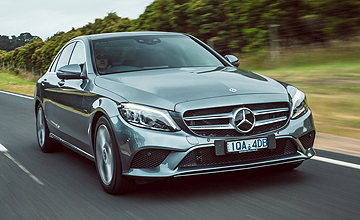
Overview
Mercedes-Benz has taken a big step closer to electrifying its entire range with the C300e plug-in electric vehicle (PHEV) hybrid, replacing the C350e with substantially better range, more power, greater speed and less consumption.
While these help justify a sizeable price jump over the standard C300 petrol, there’s one area where the C-Class PHEV drops the ball…
First drive impressions
Have they saved the best till last?
The current, fifth-generation Mercedes-Benz C-Class has never quite hit the heights of its award-winning predecessor of 2007.
With slick styling, glamorous specification, some very fast petrol engine choices and smart marketing, it is understandable why Australians went gaga for the W205 six years ago, and why it continues to sell strongly today.
But beneath that glitz, while still exceptionally well-engineered in areas of handling, safety, performance and security, the current C-Class never felt as quiet, refined, high-quality, well-made or comfortable as a Mercedes should.
And – AMG grades excepted – nor quite as fun or immersive as its better rivals either.
One by one, from the supple Jaguar XE and exquisitely-presented Audi A4 to the sublime Alfa Romeo Giulia and now the return-to-form BMW 3 Series, the Stuttgart mid-sizer seems to have been eclipsed in key areas.
2018’s makeover helped address issues of squeaky trim, noisy ride and tetchy suspension, but somehow greatness has eluded the existing C-Class.
Welcome, then, to the W205 swansong, the C300e Plug-in hybrid electric vehicle (PHEV).
To help see this generation out until the replacement surfaces later next year (we think), it arrives with a list of on-paper achievements Mensa would be proud of.
Nought to 100km/h in 5.4 seconds. 2.1L/100km. Around 50km of pure electric range and nearly 2400km between petrol refills. Brilliant.
Initial impressions aren’t stellar. Open the door and there’s a solid lightness to it rather than bank-vault thud. This is a Benz, right?
The seats are supportive but firm, ahead of a dash that, while no longer sounding like cellophane when you touch it, is clearly from earlier last decade.
The multimedia system is crying out for an overhaul, with none of the dazzling expensive desirability of the latest A-Class system also rolling out in newer Benzes with each redesign (but then it also lacks the at-times infuriatingly obstinate ‘Hey, Mercedes’ voice-control and bewildering buttons that accompany it too).
That always-annoying and cheap-feeling small column shifter is too easy to knock out of drive on the move. Enough already.
Yes, there’s acres of room up front and sufficient space in the back, but roomier rivals abound nowadays.
And the boot is some 155 litres smaller than the non-electrified version, with a huge obstruction that renders it useless for bulkier objects. Why even bother fitting the split-fold rear backrests then?
For that we can blame the PHEV system. It adds $8K over the regular (and lately improved) C300 petrol, and for what? A rubbish boot and a small ‘e’ on its lid?
However, a week in behind the wheel, it is clear that the thought and smarts that have gone behind the electrification is the future, not the past. The C300e feels like a taste of what’s coming.
Read the manual thoroughly and learn the nuances of this car, because then you can drive it properly for over 40km using just electricity for real.
Quiet, relaxing, refined – who’s said that about a C-Class over the last seven years?
Reclaiming some of that range again using deft hypermiling techniques as well as regenerative braking is fun, and plugging it in a home socket overnight like a laptop or smartphone is instantly second nature, so, yes, if your commute isn’t in Timbuktu, EV-only every day is possible.
Conversely, slipping it in Sport and using the 700Nm on tap reveals a fast sports sedan that burns off the line and reels in the road ahead at a rapid rate of knots.
After a while, when you get sick of that instant whoosh, you can learn how to eke out a couple of thousand kilometres from a 50L tank. Amazing.
Then, find a favourite string of bends and delight at how eager and informative the steering is, backed up by reassuring body control. Dynamically, this W205 is sorted.
Suddenly, that $8K premium over the regular C300 seems like a bargain. Especially when you consider that air suspension is standard, and this goes a huge way towards settling the busy and bumpy ride that has blighted too many Cs in our experience. That alone is worth the price of entry.
Returning the C300e after experiencing such sensational bandwidth was like breaking up with a hot-headed paramour, for the PHEV-tech-related highs outweigh negatives like the distasteful clatter of the petrol engine hard at work and that half-boot.
Too bad Mercedes-Benz Cars Australia can’t make the business case work for the wagon offered elsewhere, for that would at least address the latter bugbear.
Still, what we have is a flawed but fabulous C-Class in the C300e that delivers on the promise of real eco motoring while enhancing an ageing workhorse with vitality, character and charm.
As a stepping stone to a full EV future, it’s one of the best and most memorable PHEVs we’ve experienced.